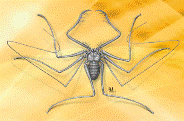Papers in the Biological Sciences

Eileen Hebets Publications
Document Type
Article
Date of this Version
2021
Citation
Published in Journal of Arachnology 49 (2021), pp. 299–316.
Abstract
The exploration of new and diverse animal groups in the study of sexual selection is both necessary and important to help better understand broad patterns and test sexual selection hypotheses regarding the evolutionary origins and maintenance of reproductive tactics and associated traits. Solifuges are, in this matter, an exceptional group and very little explored from the sexual selection point of view. At first glance, mating is apparently quite simple and conserved within this arachnid order, but solifuge reproductive behavior is unique among arachnids and more diverse than previously thought. In particular, these voracious animals appear to exhibit high sexual conflict, as males need to avoid being eaten by their aggressive female partners and mating encounters in some species involve periods of apparently male-induced female inactivity during sperm transfer. The extent to which reproductive encounters are coercive versus collaborative, however, remains largely unknown. In this review, we begin with a historical perspective of sexual behavior research in solifuges. We then discuss precopulatory mating patterns, the role of the female and male during mating, sexual dimorphism, and the influence of sexual selection during different stages of mating. In addition, we explore cases of sexual cannibalism and provide an updated analysis of how postcopulatory sexual selection may be acting on these amazing arachnids. This review shows that there is much to be done in this extraordinary group of animals.
Included in
Animal Sciences Commons, Behavior and Ethology Commons, Biology Commons, Entomology Commons, Genetics and Genomics Commons


Comments
Copyright © 2020 Peretti, Vrech, & Hebets.